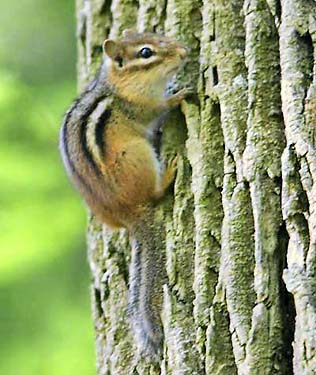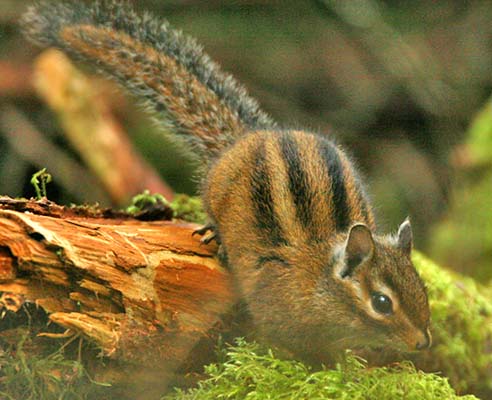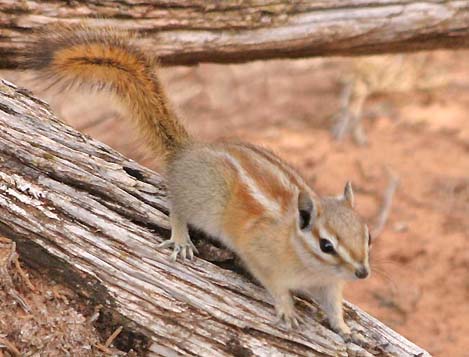CHIPMUNKS
Genus Tamias
FAMILY SCIURIDAE Squirrels & allies
Page three — non-California chipmunks
|
 Chipmunks
are a significant identification problem in western North America.
There was much confusion about taxonomy and English names in the older
literature (e.g., Ingles 1965, Harris 1985, Jameson & Peeters 1988,
Laudenslayer 1991) but things are standardized in newer publications
(Wilson & Ruff 1999, Hartson 1999, Bowers et al. 2004, Reid 2006).
The genus of all chipmunks is now Tamias, and not "Eutamias" as in older literature. Chipmunks
are a significant identification problem in western North America.
There was much confusion about taxonomy and English names in the older
literature (e.g., Ingles 1965, Harris 1985, Jameson & Peeters 1988,
Laudenslayer 1991) but things are standardized in newer publications
(Wilson & Ruff 1999, Hartson 1999, Bowers et al. 2004, Reid 2006).
The genus of all chipmunks is now Tamias, and not "Eutamias" as in older literature.
California has the bulk of North America's chipmunks with 13 species, but there are 9 other chipmunks in North America: Eastern Chipmunk in the East (right; discussed in more detail on page 1 of this set) and 8 others outside California in the West.
|
 One of the non-California species is Townsend's Chipmunk T. townsendii
(left; nice shot by Blake Matheson). In the four-way split (Sutton
& Nadler 1974, Sutton 1987), this one retains the original name. It
ranges from w. Oregon north to sw. British Columbia (range map on
previous page), and it is primarily arboreal in deep forests. It is a
large dark chimpmunk that appears to have taken on the color of its
favored woods. One of the non-California species is Townsend's Chipmunk T. townsendii
(left; nice shot by Blake Matheson). In the four-way split (Sutton
& Nadler 1974, Sutton 1987), this one retains the original name. It
ranges from w. Oregon north to sw. British Columbia (range map on
previous page), and it is primarily arboreal in deep forests. It is a
large dark chimpmunk that appears to have taken on the color of its
favored woods.
You can compare it to the other
"Townsend's splits" on the previous page, but even within species there
is variation in color patterns from the coast to inland [the latter
tend to be more grayish], so this group is best identified by voice and
range. |
The remaining seven chipmunks in the U.S. live in the arid interior of the western states. They are:
- Cliff Chipmunk T. dorsalis southeast Arizona, w. New Mexico and nw. Mexico
- Gray-footed Chipmunk T. canipes mts. of e. New Mexico, w. Texas (Guadalupe Mts.)
- Gray-collared Chipmunk T. cinereicollis Mogollon Plateau, Arizona to c. New Mexico
- Palmer's (or Charleston Mt.) Chipmunk T. palmeri Charleston Mts., s. Nevada
- Colorado Chipmunk T. quadrivitatus n. New Mexico, w. Colorado
- Red-tailed Chipmunk T. ruficaudus ne. Washington, n. Idaho, se. British Columbia, sw. Alberta
- Hopi Chipmunk T. rufus canyonlands of e. Utah, n. Arizona, w. Colorado
Finally, there are two additional chipmunks in Mexico. This brings the world total to 25 species of chipmunks.
|
 Hopi Chipmunk is common in the National Parks of eastern Utah; this shot (left) is from Arches Nat'l Park. Its scientific name is T. rufus,
and you can see why: its back and facial stripes, and the tail, are all
red — matching the red soil of that region. The rest of it is a pale
sandy gray, like sandstone. This color pattern is nothing like any
chipmunk in California. Hopi Chipmunk is a recent split from Colorado
Chipmunk, which generally occurs farther east in the Great Basin ranges
and s. Rockies. Colorado Chipmunk is common in other National Parks
(like Mesa Verde) and has darker, more blackish back stripes and a
black-tipped tail. Hopi Chipmunk is common in the National Parks of eastern Utah; this shot (left) is from Arches Nat'l Park. Its scientific name is T. rufus,
and you can see why: its back and facial stripes, and the tail, are all
red — matching the red soil of that region. The rest of it is a pale
sandy gray, like sandstone. This color pattern is nothing like any
chipmunk in California. Hopi Chipmunk is a recent split from Colorado
Chipmunk, which generally occurs farther east in the Great Basin ranges
and s. Rockies. Colorado Chipmunk is common in other National Parks
(like Mesa Verde) and has darker, more blackish back stripes and a
black-tipped tail.
Both these chipmunks eat a lot
of juniper seeds, and Colorado devours spruce seeds from cones at
higher elevations. They cache seeds for meals during winter
semi-hibernation. |
 In contrast, Cliff Chipmunk
(right) is a very gray chipmunk. The back stripes are so pale gray that
they barely contrast with the dull white stripes, and there is only a
little patch of orange on the sides. The lower facial stripe is
rusty-orange. In contrast, Cliff Chipmunk
(right) is a very gray chipmunk. The back stripes are so pale gray that
they barely contrast with the dull white stripes, and there is only a
little patch of orange on the sides. The lower facial stripe is
rusty-orange.
Cliff Chipmunk is common in western
Utah & Arizona, where it likes pinyon-juniper woodland, and it is
the only chipmunk in southern Arizona and southwestern New Mexico. This
photo (right) is from the Chiricahua Mts of southeast Arizona; it is
the only chipmunk here.
A number of the other
chipmunks in western North America, and outside of California, have
likewise distinctive patterns. This makes the new field guides very
useful (Hartson 1999, Bowers et al. 2004, Reid 2006). |
|
PHOTOS: The Eastern Chipmunk Tamias striatus was at Mt. Hollyoak, Massachusetts, on 24 June 2007. Blake Matheson photographed the Townsend's Chipmunk T. townsendii on Larch Mountain, in the middle Cascades, Orgeon, California, on 18 May 2008. The Hopi Chipmunk T. rufus was below Landscape Arch in Arches Nat'l Park on 20 Mar 2008. The Cliff Chipmunk T. dorsalis was at Cave Creek, Chiricahua Mts., Arizona, in July 1984 [the silhouetted chipmunk at top of the page is also this species]. All photos © Don Roberson, except Townsend's Chipmunk © Blake Matheson and used with permission, all rights reserved.
Literature cited:
Bowers, N., R. Bowers, and K. Kaufman. 2004. Mammals of North America. Kaufman Focus Guide. Houghton Mifflin, Boston.
Harris, J. H. 1982. Mammals of the Mono Lake-Tioga Pass Region. Kutsavi Books, Lee Vining, CA.
Hartson, T. 1999. Squirrels of the West. Lone Pine Field Guide. Lone Pine Publ., Edmonton, AB.
Ingles, L. G. 1965. Mammals of the Pacific States. Stanford Univ. Press, Stanford, CA.
Jameson, E. W., Jr., and H. J. Peeters. 1988. California Mammals. Univ. of Calif. Press, Berkeley.
Johnson, D. H. 1943. Systematic review of the chipmunks (genus Eutamias) of California. Univ. Cal. Publ. Zool. 48: 63-148.
Laudenslayer, W. F., Jr. 1991. A check-list of the amphibians,
reptiles, birds, and mammals of California. Calif. Fish & Game 77:
109-141.
Reid, F.A. 2006. Mammals of North America. Peterson Field Guides. Houghton Mifflin, Boston.
Sutton,
D. A. 1962. "Chromosomes of some Sciuridae," abstract of paper given
before the Western Society of Naturalists, San Jose, CA, cited in
Ingles (1965).
Sutton, D. A. 1987. Analysis of Pacific coast Townsend's Chipmunks (Rodentia: Sciuridae). Southwestern Naturalist 32: 371-376.
Sutton, D. A., and C. F. Nadler. 1974. Systematic revision of three Townsend's Chipmunks (Eutamias townsendii). Southwestern Naturalist 19: 199-211.
Wilson, D. E., and S. Ruff. 1999. The Smithsonian Book of North American Mammals. Smithsonian Instit. Press, Washington, D. C.
|
TOP
Page created 7-23 June 2001, revised and expanded 6-20 July 2008, revised again 18 Aug 2009 |
|
 Chipmunks
are a significant identification problem in western North America.
There was much confusion about taxonomy and English names in the older
literature (e.g., Ingles 1965, Harris 1985, Jameson & Peeters 1988,
Laudenslayer 1991) but things are standardized in newer publications
(Wilson & Ruff 1999, Hartson 1999, Bowers et al. 2004, Reid 2006).
The genus of all chipmunks is now Tamias, and not "Eutamias" as in older literature.
Chipmunks
are a significant identification problem in western North America.
There was much confusion about taxonomy and English names in the older
literature (e.g., Ingles 1965, Harris 1985, Jameson & Peeters 1988,
Laudenslayer 1991) but things are standardized in newer publications
(Wilson & Ruff 1999, Hartson 1999, Bowers et al. 2004, Reid 2006).
The genus of all chipmunks is now Tamias, and not "Eutamias" as in older literature.
 One of the non-California species is Townsend's Chipmunk T. townsendii
(left; nice shot by Blake Matheson). In the four-way split (Sutton
& Nadler 1974, Sutton 1987), this one retains the original name. It
ranges from w. Oregon north to sw. British Columbia (range map on
previous page), and it is primarily arboreal in deep forests. It is a
large dark chimpmunk that appears to have taken on the color of its
favored woods.
One of the non-California species is Townsend's Chipmunk T. townsendii
(left; nice shot by Blake Matheson). In the four-way split (Sutton
& Nadler 1974, Sutton 1987), this one retains the original name. It
ranges from w. Oregon north to sw. British Columbia (range map on
previous page), and it is primarily arboreal in deep forests. It is a
large dark chimpmunk that appears to have taken on the color of its
favored woods.  Hopi Chipmunk is common in the National Parks of eastern Utah; this shot (left) is from Arches Nat'l Park. Its scientific name is T. rufus,
and you can see why: its back and facial stripes, and the tail, are all
red — matching the red soil of that region. The rest of it is a pale
sandy gray, like sandstone. This color pattern is nothing like any
chipmunk in California. Hopi Chipmunk is a recent split from Colorado
Chipmunk, which generally occurs farther east in the Great Basin ranges
and s. Rockies. Colorado Chipmunk is common in other National Parks
(like Mesa Verde) and has darker, more blackish back stripes and a
black-tipped tail.
Hopi Chipmunk is common in the National Parks of eastern Utah; this shot (left) is from Arches Nat'l Park. Its scientific name is T. rufus,
and you can see why: its back and facial stripes, and the tail, are all
red — matching the red soil of that region. The rest of it is a pale
sandy gray, like sandstone. This color pattern is nothing like any
chipmunk in California. Hopi Chipmunk is a recent split from Colorado
Chipmunk, which generally occurs farther east in the Great Basin ranges
and s. Rockies. Colorado Chipmunk is common in other National Parks
(like Mesa Verde) and has darker, more blackish back stripes and a
black-tipped tail. In contrast, Cliff Chipmunk
(right) is a very gray chipmunk. The back stripes are so pale gray that
they barely contrast with the dull white stripes, and there is only a
little patch of orange on the sides. The lower facial stripe is
rusty-orange.
In contrast, Cliff Chipmunk
(right) is a very gray chipmunk. The back stripes are so pale gray that
they barely contrast with the dull white stripes, and there is only a
little patch of orange on the sides. The lower facial stripe is
rusty-orange.